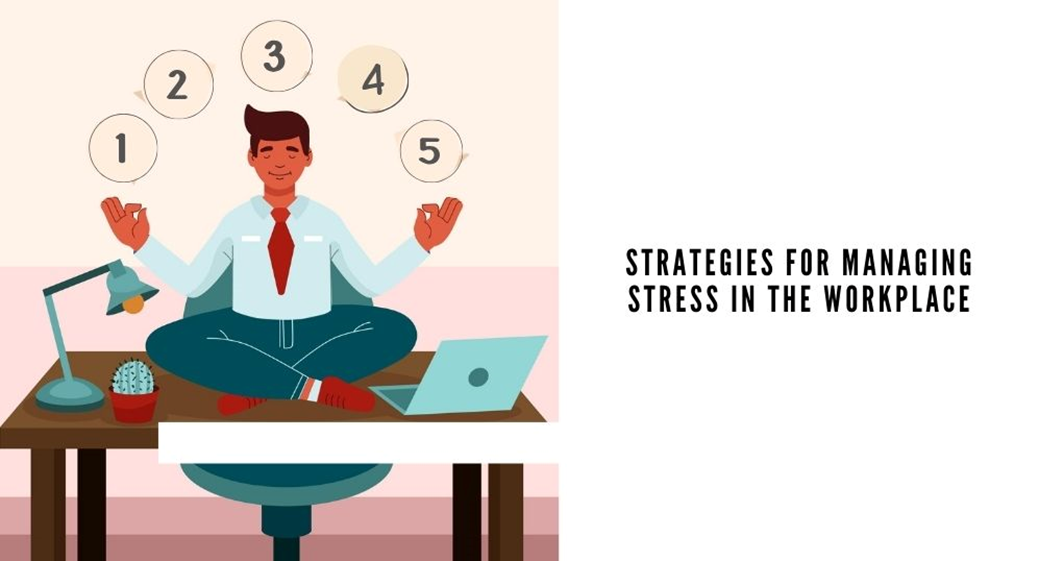
5 Simple Strategies for Managing Stress in the Workplace

In the clamouring universe of the work environment, stress is an unwanted friend that frequently prowls in the shadows. Work environment stress can be set off by a variety of elements, like unreasonable responsibility, tight cutoff times, relational struggles, and an absence of command over one's undertakings. The impacts are extensive, affecting both mental and actual wellbeing. From reduced focus and efficiency to increased uneasiness and, surprisingly, actual afflictions, the results of work environment stress can be significant.
Workplace stress is a common challenge that can affect individuals both physically and mentally. As a psychologist, I recommend five effective strategies to manage stress in the workplace. These strategies encompass a range of approaches, including mindfulness exercises, communication techniques, and lifestyle adjustments.
Mindfulness Meditation:
Mindfulness meditation involves paying attention to the present moment without judgement. Incorporating mindfulness into your daily routine can significantly reduce stress levels. Numerous studies have shown the positive impact of mindfulness on mental health, including decreased anxiety and improved overall well-being.
Advantages:- Reduced stress and anxiety
- Enhanced focus and concentration
- Improved emotional regulation
- Deep breathing: Inhale slowly for a count of four, hold for four counts, and exhale for another four counts.
- Body scan: Mentally scan your body from head to toe, focusing on each part and releasing tension.
Pros include improved mental clarity and emotional well-being. However, some individuals may find it challenging to establish a consistent mindfulness practice.
Cause and Effect:The practice of mindfulness helps individuals detach from stressors, promoting a healthier response to workplace challenges. Over time, consistent mindfulness can reshape how the brain processes stress.
Effective Communication:
Clear communication is essential for managing stress in the workplace. Expressing your thoughts and feelings, as well as actively listening to others, fosters a supportive work environment.
Advantages:- Reduced misunderstandings and conflicts
- Increased team cohesion
- Enhanced problem-solving
- Practice active listening: Give your full attention to the speaker, paraphrase their message, and ask clarifying questions.
- Use 'I' statements: Express your feelings and concerns without blaming others.
Effective communication builds strong professional relationships and mitigates stress. However, some may struggle with expressing themselves assertively.
Cause and Effect:Improved communication facilitates a more collaborative and understanding workplace, reducing the potential for stressors to escalate.
Time Management:
Proper time management is crucial for minimising workplace stress. Setting realistic goals, prioritising tasks, and creating a structured schedule can enhance productivity and reduce feelings of overwhelm.
Advantages:
- Increased productivity
- Reduced procrastination
- Enhanced work-life balance
- Prioritise tasks: Identify high-priority tasks and tackle them first.
- Break tasks into smaller steps: Dividing larger tasks into manageable steps can make them less daunting.
Effective time management leads to greater efficiency, but some individuals may find it challenging to adhere to a structured schedule.
Cause and Effect:A well-managed schedule allows for more control over work-related stressors, preventing the accumulation of tasks and deadlines.
Physical Exercise:
Regular physical activity is a powerful stress management tool. Exercise releases endorphins, which act as natural mood lifters, and it also helps the body and mind cope with stress.
Advantages:- Stress reduction
- Improved mood and energy levels
- Better physical health
- Cardiovascular exercises: Running, cycling, or brisk walking.
- Strength training: Lifting weights or using resistance bands.
Physical exercise is a holistic stress management approach, but time constraints or physical limitations may pose challenges for some individuals.
Cause and Effect:Engaging in regular exercise positively influences both physical and mental health, contributing to an overall reduction in stress levels.
Boundary Setting:
Establishing clear boundaries between work and personal life is crucial for managing stress. Striking a balance between professional and personal commitments helps prevent burnout and maintains overall well-being.
Advantages:- Reduced risk of burnout
- Improved work-life balance
- Enhanced overall satisfaction
- Set specific work hours: Establish a clear start and end time for your workday.
- Learn to say no: Prioritise tasks and avoid overcommitting.
Setting boundaries preserves mental and emotional health, but some individuals may feel pressured to always be available.
Cause and Effect:Maintaining clear boundaries allows for a healthier separation between work-related stressors and personal life, preventing the two from intertwining.
In summary, managing workplace stress involves a multifaceted approach that addresses various aspects of one's life. Mindfulness meditation, effective communication, time management, physical exercise, and boundary setting are essential strategies recommended by psychologists. Incorporating these practices into daily life can lead to a more resilient and balanced approach to work-related stress, promoting both mental and physical well-being. It's important to note that the effectiveness of these strategies may vary among individuals, and a personalised approach may be necessary for optimal results.
image credit : freepik

Mpowering Minds 2026 – Women’s Mental Health Summit: Championing a New Era of Well-Being
Therapy Approaches That Help Heal Intergenerational Trauma: CBT, DBT, Somatic Work & More

